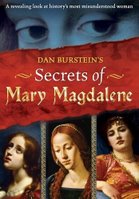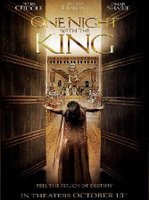There’s been so much going on
this month, that I’ve been unable to do much reviewing here recently. However, as I have finally got hold of a copy of Abel Ferrara’s
Mary (on
DVD) then I thought I would start by reviewing the other recent film on the subject,
Mary Magdalene from Time Life’s
Close to Jesus series
========

2006 has been a big year for films about Mary Magdalene. Although technically 2005 (by a whisker), Abel Ferrara’s
Mary gained widespread acclaim early in the year as it played at film festivals before enjoying a limited run in theatres. Sadly it never got a proper release in the US and the UK and so few, in the English speaking world at least, have even heard of it. By contrast, the year’s other film about Mary was so hyped up that it was impossible to avoid. Based on a best-selling
novel,
The Da Vinci Code was always going to be a big deal. Whilst its glimpses of Mary Magdalene are fleeting, it is probably even more influential today, in terms of how people in the west view Mary Magdalene, than the bible.
As Dan Brown would be keen to point out, history has not always been so kind to her. The earliest film about Mary was made in 1914 (
Mary Magdalene). Although it is now lost, it appears that Mary was in love with Judas, but discovers Jesus and becomes his follower. In order to stay close to Mary, Judas also becomes his follower. Thirteen years later, Cecil B DeMille would use a similar plot device in his
The King of Kings only in this instance Judas would follow Jesus first.
Whilst Mary continued to be portrayed in the majority Jesus films, most portrayed her as a prostitute despite the lack of biblical and early Christian evidence for such a position. But apart from that she had the title role only twice more; in the Mexican film
Mary Magdalene (1946), and in the Italian film
Mary Magdalene (
La Spade e la Croce - 1959) starring Yvonne De Carlo (who had played Sephora in
The Ten Commandments).
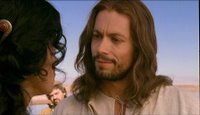
That is until Lux Vide decided to film four spin-offs from their Bible Collection series. The
Close to Jesus series features fictional reconstructions of the lives of four of the more peripheral characters from the Gospels – Thomas, Joseph (of Nazareth), Judas, and Mary Magdalene. These four films effectively sever all ties with the earlier Bible Collection film
Jesus. Whereas the role of Mary on that film was played by
Will and Grace’s Debra Messing, here the role is taken by Maria Grazia Cucinotta. Likewise Jeremy Sisto has been replaced, by a Danny Quinn. Quinn’s portrayal is halfway between Sisto and Johnny Depp, and is arguably the weakest aspect of the film.
There is another, important but subtle, distinction that needs to be made between the two films. Whilst there is much in
Jesus that is interpretative or fictional, those aspects are based on the historical texts of the gospels. One may disagree with how they have interpreted or extrapolated those texts, but essentially they have tried to fill in the gaps to address modern concerns with a historical figure.
Mary Magdalene is quite different in this regard. Not only is there insufficient material to use as a reasonable basis for extrapolation, but the film deliberately avoids the Mary of the gospels. So the biblical scenes which include Mary, her exorcism (Luke 8:2), and her presence at his death (Mark 15:40) and resurrection (John 20:1f) are entirely absent. This contrasts strongly with other made for TV films about these characters, such as 2004’s
Judas which attempts to construct a credible series of events leading up to the moment that would assure them of their place in history.
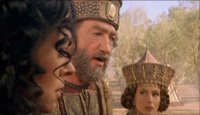
That is not to say the story here is entirely unwarranted. Whilst the exorcism scene is absent from this film, the minor details in the opening verses of
Luke 8 are incorporated. Mary’s closest friends in this film are called Joanna and Susanna. This typifies the film’ approach – the focus is on Mary and her pre-conversion life, but it locates her at other places in the story where the gospels do not, most notably in the court of Herod. Interestingly, Joanna, here, is not the wife of Chuza, manager of Herod’s household, as in Luke’s gospel, (Luke’s inclusion of this detail suggests that she may have been the original source for the more private details of Herod’s dealings with John, such as Mark 6:20). But this detail - one of Jesus’s followers being intimately acquainted with aspects of Herod’s house – has been credited to Mary instead, which allows it to be explored more fully.
Mary also witnesses various examples of Jesus’s teaching and miracles, in a variety of locations, and the film treats these incidents with varying degrees of respect. For example at times Mary is simply the witness to a piece of teaching or of a miracle. It happens more or less as the gospels record, although obviously interpreted on a visual level. Yet at others Mary’s presence is more intrusive. When, early on in the story, Mary attempts to drown herself she is saved by Peter’s nets as he makes his miraculous catch of fish. Whilst it’s perhaps a playful literalisation of Jesus’s promise to make him a fisher of men, you cannot imagine the gospel writers leaving it out had it truly occurred.
Such intrusions are rare. What this film does do well is put the emphasis on Jesus’s original audience. In most Jesus films, Jesus is the main character. The very nature of having 12 disciples means that few of them get any real screen time, and too much exploration of their histories would disturb the flow of the narrative. An alternative approach is that taken by the fifties biblical epics which focussed on characters who lives were changed by Jesus. In most cases, however, these characters were changed by Jesus’ actions (particularly his sacrificial death) rather than his teaching. The one exception here is
Salome (1953) a revisionist version of the deatjh of John the Baptist which ultimately shows the eponymous heroine being changed by Jesus’s words, and climaxes in the Sermon on the Mount.
Here, however, Jesus get a far greater screen time than in those fifties films (plus we get to see his face), but the focus of the film is clearly on one specific member of his audience. This allows the viewer to more readily adopt the position of Jesus’s original audience, and understand some of the exegetical subtleties involved through this fresh angle. For example, Mary’s hitherto idyllic life is brought to an abrupt end in the opening moments of the film when her husband gives her a divorce simply because she is barren. This draws attention to the fact that this was permissible at the time (although certainly under review), whilst also preparing the ground for Jesus’s teaching on it, rooted in equality, and limiting its acceptability. But, Jesus’s call to love your enemies fails to have any initial impact on an embittered and vengeful Mary.
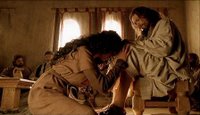
This aspect of the film reaches its climax in the scene where Mary anoints Jesus. It’s a strange episode to choose. Whilst the gospels either leave this woman unnamed (Mark 14, Matt 26, Luke 7) or identify her as Mary of Bethany (John 12), church tradition somehow confused over the differing accounts and the various Mary’s in the gospels, and formulated a mythical Mary Magdalene. This Mary was a repentant, adulteress prostitute saved from a stoning to become Jesus follower, who expressed her gratitude through this dramatic anointing.
Whilst it is, therefore, questionable whether this story had anything to do with the real Mary Magdalene, the film uses its ahistorical perspective to good effect. This scene, coming near the end of the film, is easily its most powerful. By then we are so well acquainted with this Mary, that her freedom from bitterness, and her emotional response give this oft depicted scene fresh power. There’s also a clever touch here, as one of those outraged by Mary’s actions calls her a prostitute, a nod towards the tradition mentioned above which the film categorically avoids.
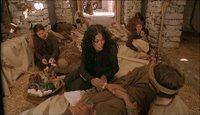
The film ends sometime after the crucifixion as it started, with a Mary bringing someone healing. There’s an interesting circularity here. The Mary of the opening scenes was happy, and sufficiently at peace with herself that she was able to and care for and heal those around her. Her divorce and her subsequent treatment transformed her into an angry, bitter and hurting woman. Renewed and restored by Jesus she is able to return to her initial calling, although this time in his power. In many ways, though, Jesus has only restored the equilibrium, rather than performed a transformation.
The fact of the matter is that we know precious little about Mary’s life, and I suspect if you asked the makers of this film they would happily admit that this is almost entirely speculation. At the same time, such speculation, if handled correctly, can shed new light on the gospels, and the impact Jesus’s words may have had on his original audiences.



















